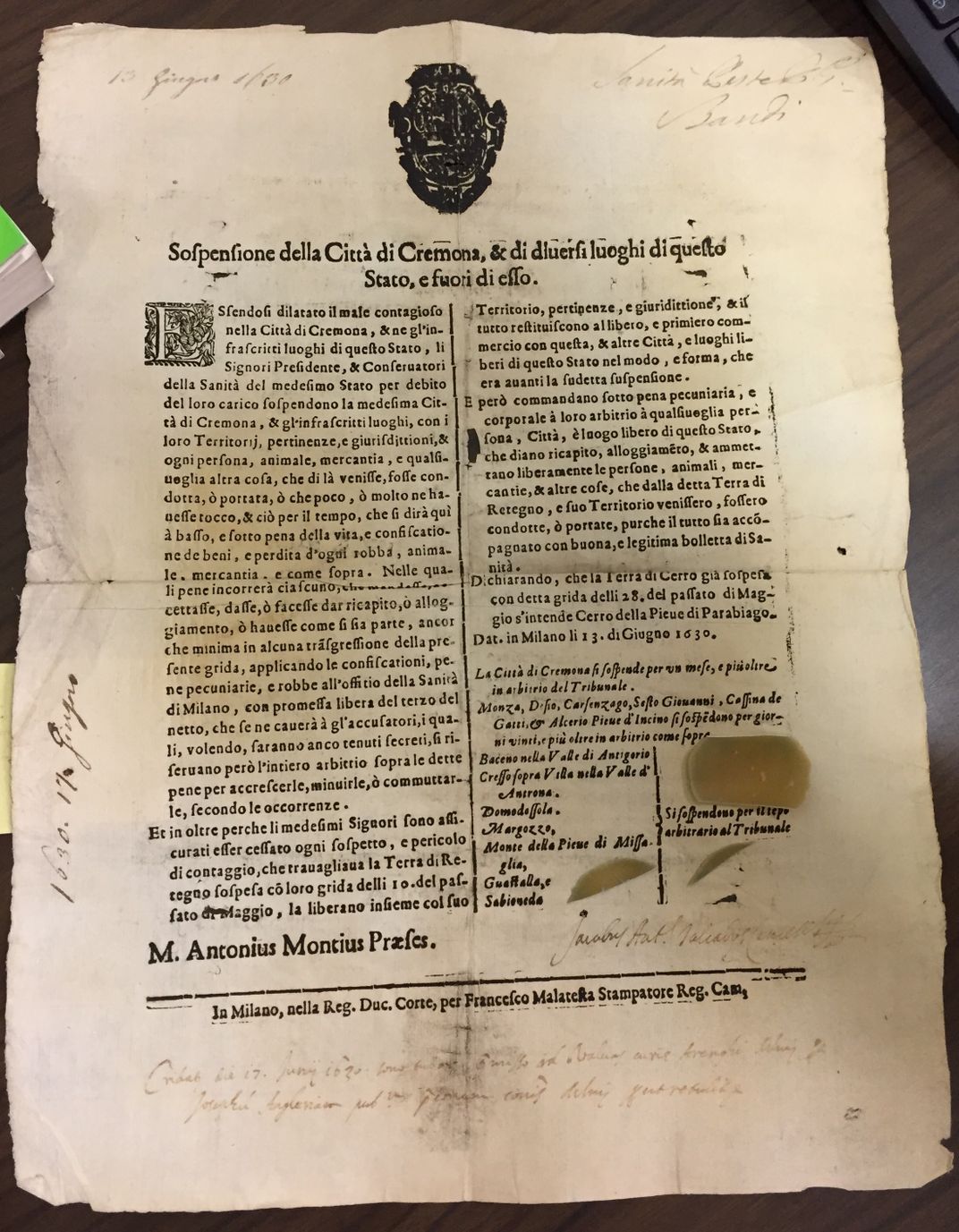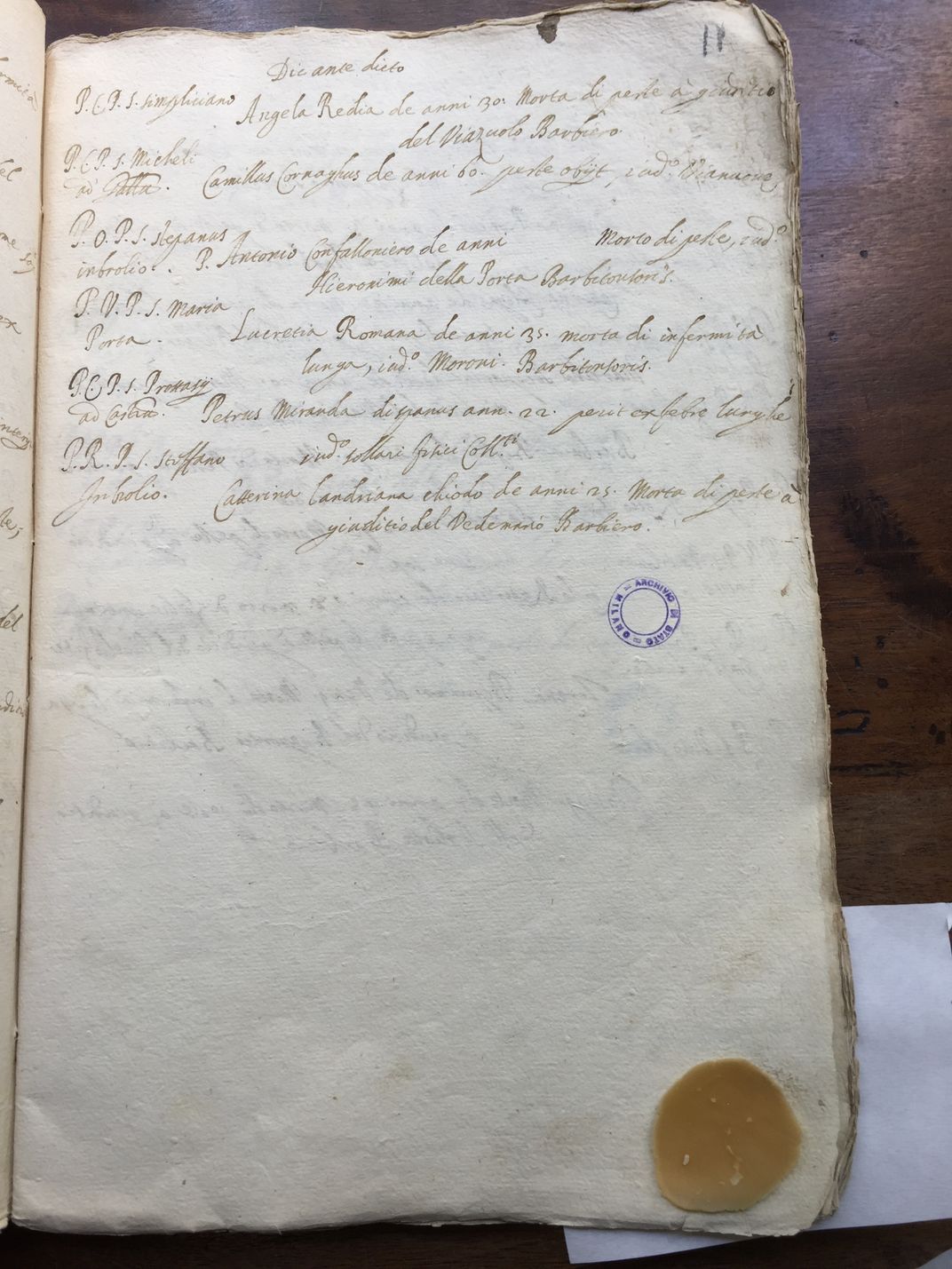How Proteins Helped Scientists Read Between the Lines of a 1630 Plague Death Registry
New tech reveals bacterial contamination, what scribes were eating and how many rats were around
/https://tf-cmsv2-smithsonianmag-media.s3.amazonaws.com/filer/cc/74/cc747f97-484b-436b-ab11-a18057f667b6/eanrtr2.jpg)
For centuries, the plague was a vicious harbinger of death across Europe. It brought devastation to cities and rural villages at irregular intervals, and from 1629 to 1630 it alighted upon Milan, Italy. The unimaginable death toll—60,000 people in a city of 130,000—imprinted itself on the Italian imagination, eventually coming to be featured in Alessandro Manzoni’s 19th century novel The Betrothed.
During the long Milano plague season, scribes recorded the names and ages of every individual who perished in meticulous death registries. Now, it turns out those detailed documents held more than names and dates—they were also full of invisible stories hiding among the written records.
Nearly 400 years later, scientists have returned to uncover new details about the environmental conditions around the manuscripts, from what those scribes were eating to the animals kept nearby. The discoveries were all thanks to a game-changing technology: polymer disks that extract centuries-old proteins from the paper. Their findings, recently published in the Journal of Proteomics, detail everything from the prevalence of rodents to the enormous quantity of bacteria all around the manuscripts—and open up a new avenue of inquiry for other crucial historical texts.
“We started this research a few years ago from a basic idea, that papers and manuscripts absorb different proteins from the writer and the environment around the paper,” says physicist Gleb Zilberstein, one of the study’s authors. But they never would have guessed how much those proteins would reveal.
The first clue that uncovering such details might be possible came from an unlikely source: brown, circular polymer disks made from ethyl-vinyl acetate, originally meant for manuscript preservation, Zilberstein says. His team had tried using them to remove harmful acids in the cellulose-based paper of the 75-year-old notebooks of Mikhail Bulgakov, Russian author of The Master and Margarita.
Upon removing the disks, they discovered that the polymers were also full of proteins, which could provide rich data about the authors’ environmental conditions. In fact, proteins can be a better source of such data than DNA, says Zilberstein. “Most people who work in biochemical characterization of artifacts use genomes,” Zilberstein says. “It’s good, but DNA is less stable than the peptides in proteins.” This type of analysis is called proteomics, and it’s only been refined in the past few years.
With the Milan manuscripts, they went about the process more purposefully, leaving the EVA disks on the pages for 60 to 90 minutes to allow proteins to adhere to the disk without causing any degradation to the paper. Those peptide chains—amino acids linked like Lego blocks—were then analyzed in a mass spectrometry machine and identified using protein databases. The researchers retrieved more than 70,000 peptide sequences comprising 600 different protein families from the 11 pages of the death registry, and a one-page notice kept in the same archive.

While peptides might be more stable than DNA, they come with their own inconveniences: they’re also much harder to identify. This was one challenge with the 1630 documents, the researchers say. As biochemist Kathryn Stone writes in a 2013 report on proteomics technology, “Protein structure can be much more heterogeneous than DNA structure,” which requires researchers to make inferences about where the peptides came from.
"Proteins are indeed more stable in some ways than DNA, but have less discriminatory power at the sequence level. Also, even though you may find traces of proteins, discriminating them from contamination is a lot harder than it is from DNA," said Hendrik Poinar, an evolutionary biologist at the McMaster Ancient DNA Centre who was not involved in the research, by email. But even with those caveats, Poinar added of the EVA disk analysis, "I say, 'Great start, onwards!'"
The researchers found 312 peptide sequences that matched known bacteria. Then, they narrowed that number down to 17 that fell in the Yersinia family—the bacteria responsible for Y. pestis, or the bubonic plague. But the proteins don’t belong exclusively to Y. pestis. They could also belong to other species of Yersinia bacteria, including some that aren’t deadly to humans.
As Ann Carmichael, a history professor emeritus at Indiana University at Bloomington who has spent her academic career researching the medical history of the plague, puts it: “The identification of the proteins are only as good as the database they’ve compiled.” But that doesn’t mean she’s not intrigued by the new research. “It’s exciting material and I think there will be a lot of refining in the labs,” says Carmichael, who also wasn't involved in the new study.
Carmichael’s first reaction to the new study was the disgust of realizing that all these particles were in manuscripts she’d handled. “We’ve all thumbed through the pages of manuscripts and I’ve spent a lot of time with Milanese documents,” she says. One of her colleagues even came across mouse droppings in the pages of the manuscript she was reviewing. Apart from the “ewww” of knowing the ratio of rat proteins to human proteins was nearly one-to-one, Carmichael found the discoveries fascinating.
University of Texas historian Stefano D’Amico agrees that the new technique can offer insights that the text and its production alone couldn’t. Specifically, he pointed to the finding that the scribes were eating mainly maize, potatoes, chickpeas, rice and carrots, and that sheep and goats were somewhere in the lazaretto, which housed the sick. (The authors speculate that those farm animals may have been housed in the quarantined lazaretto to feed infants whose mothers died of the plague.)
“All the information about the diet of these people, what they ate at the time, what kind of animals were in the area of the lazaretto—the environment in which these people were operating—this is all important to historians,” D’Amico says.

Of course, the registries themselves have plenty to say about how the plague upended Italian society during the Renaissance. Carmichael, who has reviewed documents from the centuries before 1630, was struck by the consistency of the administrators recording the names and deaths of these individuals. “They show up for work, they do the same thing over and over. It is a tedious, thankless job. And the only time you don’t find these records is when the plague gets so bad that record-keeping collapses. But they still try to do it.”
The fastidious documentation, then, was an effort to impose order on a chaotic situation. The idea was to help officials identify when new outbreaks of the plague were beginning, so that they could quarantine the city from trade with other cities, and begin rounding up afflicted individuals to transport them to encampments or the lazaretto, an enormous structure outside the city that housed as many as 9,000 people in and around its grounds. While some people afflicted with the plague went there willingly, most were forcibly removed from the city along with their families and other contacts.
“Once inside, you were basically a prisoner,” D’Amico says. “There was one entrance and it was guarded by soldiers. You could only get out if you survived the epidemic.”
Being constantly threatened with death took its toll on civilians. “These are the centuries when Europe is colonizing the globe and all sorts of things are happening—the Renaissance, the Reformation, the Scientific Revolution—and the plague is an interruption,” Carmichael says. “Daniel Defoe said plague was an unseen mine: you step on it, and it blows up and changes your life.”
For Zilberstein and the chemists who developed this technology, learning more about what life was like during the plague is only the beginning. The EVA disks could have any number of applications for historians and archivists hoping to uncover more information about their documents. For instance, Zilberstein says they hope to investigate the original papers of writers like Anton Chekhov and Friedrich Nietzsche, to see whether they were using any medicines or suffering from any medical conditions at the time of writing their books.
There are some caveats. Different countries have different climates, and some manuscripts might be contaminated with more modern proteins, depending on how they’re handled. But Zilberstein believes that plucking up peptides is still a fruitful way forward in cultural heritage research. As he says, “We can read the hidden data from old sources of paper-based information.”
/https://tf-cmsv2-smithsonianmag-media.s3.amazonaws.com/accounts/headshot/lorraine.png)
/https://tf-cmsv2-smithsonianmag-media.s3.amazonaws.com/accounts/headshot/lorraine.png)